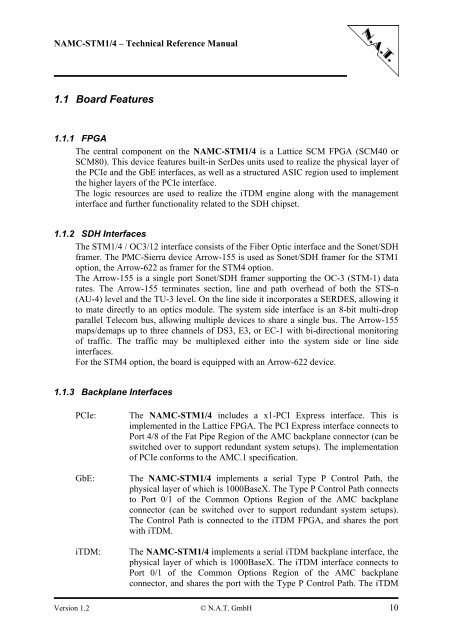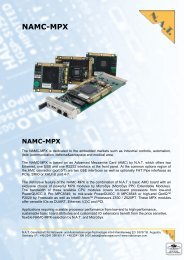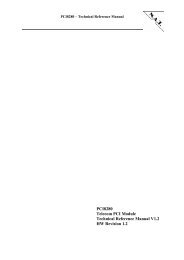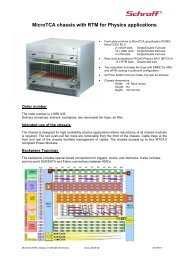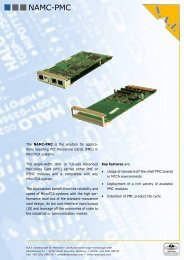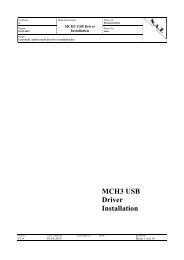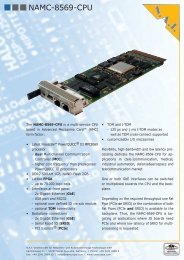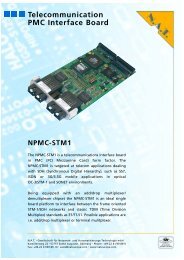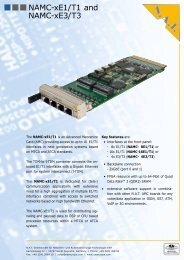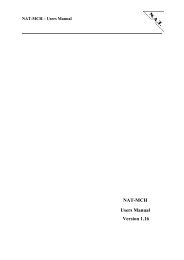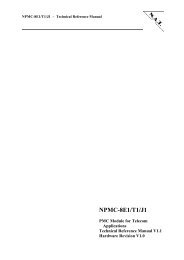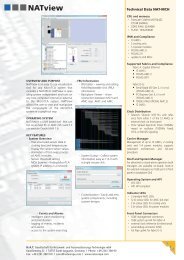NAMC-STM1/4 Telecom AMC Module Technical Reference ... - NAT
NAMC-STM1/4 Telecom AMC Module Technical Reference ... - NAT
NAMC-STM1/4 Telecom AMC Module Technical Reference ... - NAT
Create successful ePaper yourself
Turn your PDF publications into a flip-book with our unique Google optimized e-Paper software.
<strong>N<strong>AMC</strong></strong>-<strong>STM1</strong>/4 – <strong>Technical</strong> <strong>Reference</strong> Manual<br />
1.1 Board Features<br />
1.1.1 FPGA<br />
The central component on the <strong>N<strong>AMC</strong></strong>-<strong>STM1</strong>/4 is a Lattice SCM FPGA (SCM40 or<br />
SCM80). This device features built-in SerDes units used to realize the physical layer of<br />
the PCIe and the GbE interfaces, as well as a structured ASIC region used to implement<br />
the higher layers of the PCIe interface.<br />
The logic resources are used to realize the iTDM engine along with the management<br />
interface and further functionality related to the SDH chipset.<br />
1.1.2 SDH Interfaces<br />
The <strong>STM1</strong>/4 / OC3/12 interface consists of the Fiber Optic interface and the Sonet/SDH<br />
framer. The PMC-Sierra device Arrow-155 is used as Sonet/SDH framer for the <strong>STM1</strong><br />
option, the Arrow-622 as framer for the STM4 option.<br />
The Arrow-155 is a single port Sonet/SDH framer supporting the OC-3 (STM-1) data<br />
rates. The Arrow-155 terminates section, line and path overhead of both the STS-n<br />
(AU-4) level and the TU-3 level. On the line side it incorporates a SERDES, allowing it<br />
to mate directly to an optics module. The system side interface is an 8-bit multi-drop<br />
parallel <strong>Telecom</strong> bus, allowing multiple devices to share a single bus. The Arrow-155<br />
maps/demaps up to three channels of DS3, E3, or EC-1 with bi-directional monitoring<br />
of traffic. The traffic may be multiplexed either into the system side or line side<br />
interfaces.<br />
For the STM4 option, the board is equipped with an Arrow-622 device.<br />
1.1.3 Backplane Interfaces<br />
PCIe: The <strong>N<strong>AMC</strong></strong>-<strong>STM1</strong>/4 includes a x1-PCI Express interface. This is<br />
implemented in the Lattice FPGA. The PCI Express interface connects to<br />
Port 4/8 of the Fat Pipe Region of the <strong>AMC</strong> backplane connector (can be<br />
switched over to support redundant system setups). The implementation<br />
of PCIe conforms to the <strong>AMC</strong>.1 specification.<br />
GbE: The <strong>N<strong>AMC</strong></strong>-<strong>STM1</strong>/4 implements a serial Type P Control Path, the<br />
physical layer of which is 1000BaseX. The Type P Control Path connects<br />
to Port 0/1 of the Common Options Region of the <strong>AMC</strong> backplane<br />
connector (can be switched over to support redundant system setups).<br />
The Control Path is connected to the iTDM FPGA, and shares the port<br />
with iTDM.<br />
iTDM: The <strong>N<strong>AMC</strong></strong>-<strong>STM1</strong>/4 implements a serial iTDM backplane interface, the<br />
physical layer of which is 1000BaseX. The iTDM interface connects to<br />
Port 0/1 of the Common Options Region of the <strong>AMC</strong> backplane<br />
connector, and shares the port with the Type P Control Path. The iTDM<br />
Version 1.2 © N.A.T. GmbH 10


